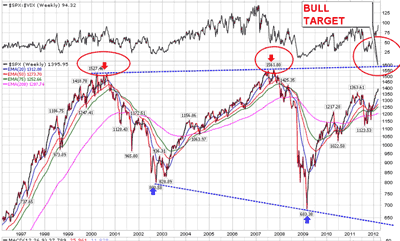This chart, courtesy Contrarian Advisor, provides a great view of where we are, and it predicts that the S&P gets to above 1500, if not to 1600, in fairly short order:
(click to enlarge)
The big picture view is that since 2000 we have been in a large corrective triangle that is leading to a triple top in the S&P around the 1550 range, with tops in 2000, 2007 and 2012. The shape of the triangle is a Barrier Triangle, with a barrier around 1500-1600 and an expanding bottom below Sp800. The implication is a drop from 2013 – 2015 down to the lower trend line, meaning to new lows below the March 2009 Sp667 intraday low.
The doom & gloom crowd remains strident in calls for an imminent P3 wave down, despite the inexorable rise of the market. Their position is getting harder to support, if it has even been very supportable for a while. After a big drop as we had in 2008, the bounce usually goes 50-62%, but seldom beyond; if it gets about 70.7%, and especially 78.6%, it almost always goes back to the old highs. We hit the 62% retracement a while ago, and odds then switched to running up to a new high.
An alternative view to the Big Triangle is that the 2000-2009 drop is a classic Flat correction. This makes the wave up either the start of a new bull market – which should exceed the 2007 highs – or a corrective X wave with another down pattern to follow. Since that structure will be horizontal, given how this correction has so far unfolded, it also suggests the X wave will go back to the 1550 range.
X waves are not well understood in wave analysis, since they seem like a “plug” of a failed structure, but they are a very standard feature in markets, especially in extended corrective structures of a sort that don’t break as triangles. So far the correction since 2000 has gone 12 years, so a wave analysts should look for a triangle or a series of horizontal corrective patterns connected by X waves.
X waves tend to be simpler than the corrective patterns they connect, and therefore are usually zigzags – sharp rises, as we have seen since 2009. This one seems to be resolving as a large double zigzag, where the first zigzag rose into 2011, and after the big May to Oct correction, we started the second zigzag, which we are still in. Simple fibonacci analysis says it should go to the 1550 range: using the weekly numbers above, the first wave rose 680 points, and the second zigzag should run 61.8% to 100% of the first one. Using 61.8% of 680 points, we get a target of 1544.
Usually stocks run up in an election year – and even more so in the year before – and then correct hard afterwards. Why is not hard to figure: the incumbent tries to get re-elected and uses whatever ways he can to pump the economy, then takes a huge hit in the first year to give his party a shot at another recovery into the next election. This is the Four-Year Cycle, the most predictable stock market cycle because it is driven by actions in the real economy. At a simple level, one could just stay long and pull out before 2013, when a whole bucket of negative events happen, like the repeal of tax breaks that are pumping the economy up.
Technical analysis supports this fundamentals view right now.
- Bulenox: Get 45% to 91% OFF ... Use Discount Code: UNO
- Risk Our Money Not Yours | Get 50% to 90% OFF ... Use Discount Code: MMBVBKSM
Disclaimer: This page contains affiliate links. If you choose to make a purchase after clicking a link, we may receive a commission at no additional cost to you. Thank you for your support!





Leave a Reply